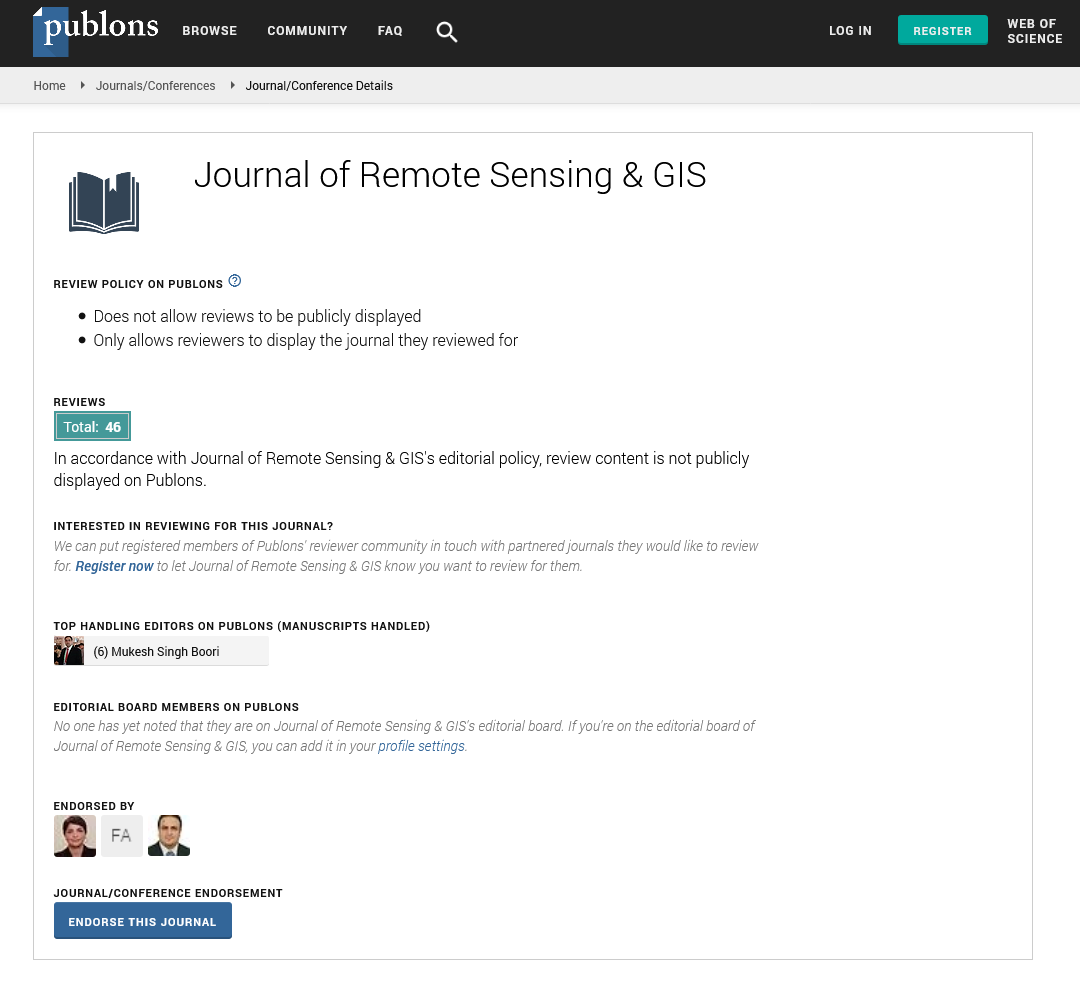Indexed In
- Open J Gate
- RefSeek
- Hamdard University
- EBSCO A-Z
- OCLC- WorldCat
- Publons
- International Scientific Indexing
- Euro Pub
- Google Scholar
Useful Links
Share This Page
Journal Flyer

Open Access Journals
- Agri and Aquaculture
- Biochemistry
- Bioinformatics & Systems Biology
- Business & Management
- Chemistry
- Clinical Sciences
- Engineering
- Food & Nutrition
- General Science
- Genetics & Molecular Biology
- Immunology & Microbiology
- Medical Sciences
- Neuroscience & Psychology
- Nursing & Health Care
- Pharmaceutical Sciences
Commentary Article - (2024) Volume 13, Issue 2
Remote Sensing Technologies for Disaster Risk Reduction and Management
Kun Zhao*Received: 03-Jun-2024, Manuscript No. JGRS-24-26262; Editor assigned: 06-Jun-2024, Pre QC No. JGRS-24-26262 (PQ); Reviewed: 20-Jun-2024, QC No. JGRS-24-26262; Revised: 27-Jun-2024, Manuscript No. JGRS-24-26262 (R); Published: 04-Jul-2024, DOI: 10.35248/2469-4134.24.13.340
Description
Natural disasters including earthquakes, hurricanes, floods and wildfires, pose significant threats to human life, infrastructure and ecosystems. Since they offer essential information and insights for preventing, planning for, responding to, and recovering from these catastrophic events, remote sensing technologies have become indispensable instruments in disaster risk reduction and management.
Understanding remote sensing technologies
Remote sensing involves the acquisition of information about the Earth's surface and atmosphere without direct contact. This is achieved through sensors mounted on satellites, aircraft, or drones, which capture data across various wavelengths of the electromagnetic spectrum. The collected data is then processed and analyzed to monitor and assess environmental conditions and changes. Key remote sensing technologies used in disaster risk reduction and management include:
Optical remote sensing: Optical sensors capture images in the visible, near-infrared, and shortwave infrared regions of the spectrum. These images provide detailed information on land cover, vegetation health, and surface temperatures, which are essential for monitoring and managing natural disasters.
Synthetic Aperture Radar (SAR): SAR uses microwave signals to create high-resolution images of the Earth's surface, regardless of weather conditions or daylight availability. SAR is particularly useful for detecting changes in land elevation, mapping flood extents, and monitoring soil moisture levels.
Light Detection and Ranging (LiDAR): LiDAR technology uses laser pulses to measure distances between the sensor and the Earth's surface, generating precise three-dimensional maps of terrain and vegetation. LiDAR is valuable for assessing topography, mapping hazard zones, and monitoring changes in landscape features. Thermal Infrared Imaging: Thermal sensors detect heat emitted from the Earth's surface, providing data on surface temperatures and thermal anomalies. This information is critical for monitoring wildfires, volcanic activity, and heatwaves.
Applications of remote sensing in disaster risk reduction and management
Remote sensing technologies play a critical role in various phases of disaster risk reduction and management, including mitigation, preparedness, response, and recovery.
Hazard assessment and mapping: Remote sensing provides detailed and up-to-date information on hazard-prone areas, helping to identify and map regions at risk of natural disasters. For example, satellite imagery can be used to map fault lines and assess earthquake risks, while LiDAR data can identify areas vulnerable to landslides. This information is essential for developing hazard maps and land-use planning strategies to mitigate disaster risks.
Early warning systems: Remote sensing technologies enable the continuous monitoring of environmental conditions, providing early warnings for impending disasters. For instance, meteorological satellites track the development and movement of hurricanes and typhoons, while SAR sensors monitor changes in soil moisture that can indicate potential floods. Early warning systems rely on real-time remote sensing data to issue alerts and enable timely evacuation and preparedness measures.
Disaster response and damage assessment: In the immediate aftermath of a disaster, remote sensing technologies provide rapid and accurate assessments of the affected areas. High- resolution satellite imagery and aerial photographs help identify damaged infrastructure, assess the extent of flooding, and locate areas in need of urgent assistance. This information is critical for coordinating emergency response efforts, allocating resources, and prioritizing relief operations.
Monitoring and managing wildfires: Thermal infrared sensors detect and monitor wildfires by capturing heat signatures and thermal anomalies. Remote sensing data can track the spread of fires, identify hotspots, and assess the effectiveness of firefighting efforts. Additionally, satellite imagery can be used to map fire- affected areas, evaluate vegetation loss, and plan reforestation and land restoration activities.
Flood monitoring and management: Remote sensing technologies, such as SAR and optical imagery, provide valuable data for monitoring and managing floods. SAR can penetrate cloud cover and capture images during heavy rainfall, making it ideal for tracking flood extents and assessing inundation areas. Optical imagery provides detailed information on water levels, river dynamics, and floodplain changes. This data supports flood forecasting, early warning systems, and the development of flood mitigation measures.
Post-disaster recovery and rehabilitation: Remote sensing technologies play a crucial role in the recovery and rehabilitation phase of disaster management. High-resolution imagery and LiDAR data are used to assess infrastructure damage, monitor rebuilding efforts, and evaluate the effectiveness of recovery programs. Remote sensing also helps track environmental changes and the long-term impacts of disasters on ecosystems and communities.
Remote sensing technologies have become indispensable tools for disaster risk reduction and management. By providing comprehensive, high-resolution, and timely data, these technologies support hazard assessment, early warning systems, disaster response, and post-disaster recovery. As advancements in remote sensing continue, their applications in disaster management will expand, offering even more precise and actionable insights for safeguarding communities and ecosystems from the impacts of natural disasters.
Citation: Zhao K (2024) Remote Sensing Technologies for Disaster Risk Reduction and Management. J Remote Sens GIS. 13.340.
Copyright: © 2024 Zhao K. This is an open-access article distributed under the terms of the Creative Commons Attribution License, which permits unrestricted use, distribution, and reproduction in any medium, provided the original author and source are credited.

